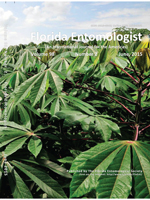Several new whitefly (Hemiptera: Aleyrodidae) species have become established in Florida in the past decade. Three of these, fig whitefly (FW), rugose spiraling whitefly (RSW), and Bondar's nesting whitefly (BNW), have caused noticeable damage to residential plants in the landscape including ficus hedges, palms, and bird of paradise. Whiteflies are difficult to identify and 4th instar nymphs are needed for morphological identification making whiteflies good candidates for identification via DNA barcoding. A DNA barcoding cocktail to amplify the 5′ end of the coxI mitochondrial gene from these species was developed. Subsequently, primers were developed for each species, validated with multiple populations collected throughout Florida, and a phylogenetic tree was constructed for placement of the 3 species in the whitefly tree of life. Besides FW, RSW, and BNW, 2 additional species of whiteflies were detected in collections, namely Paraleyrodes pseudonaranjae Martin (Hemiptera: Aleyrodidae) and a species provisionally designated Aleurodicinae sp1. RSW and BNW clustered with congeners within the phylogeny, and FW was resolved as a possible sister taxa to the genus Bemisia. The barcoding cocktail should allow sequencing of 5′ coxI from multiple genera and both sub-families of whiteflies, and the primers developed for each species will facilitate rapid identification of these 3 invasive whiteflies.
How to translate text using browser tools
1 June 2015
DNA Barcode Development for Three Recent Exotic Whitefly (Hemiptera: Aleyrodidae) Invaders in Florida
Aaron M. Dickey,
Ian C. Stocks,
Trevor Smith,
Lance Osborne,
Cindy L. McKenzie

Florida Entomologist
Vol. 98 • No. 2
June 2015
Vol. 98 • No. 2
June 2015
Aleurodicus rugioperculatus
coxI
coxI barcoding
especies invasoras
invasive species
Paraleyrodes bondari
Paraleyrodes pseudonaranjae




